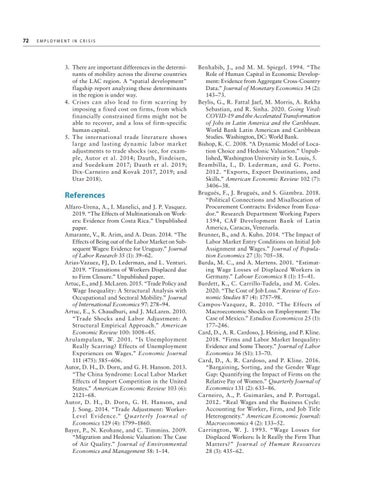72 E m p l o y m e n t
in Crisis
3. There are important differences in the determinants of mobility across the diverse countries of the LAC region. A “spatial development” flagship report analyzing these determinants in the region is under way. 4. Crises can also lead to firm scarring by imposing a fixed cost on firms, from which financially constrained firms might not be able to recover, and a loss of firm-specific human capital. 5. The international trade literature shows large and lasting dynamic labor market adjustments to trade shocks (see, for example, Autor et al. 2014; Dauth, Findeisen, and Suedekum 2017; Dauth et al. 2019; Dix-Carneiro and Kovak 2017, 2019; and Utar 2018).
References Alfaro-Urena, A., I. Manelici, and J. P. Vasquez. 2019. “The Effects of Multinationals on Workers: Evidence from Costa Rica.” Unpublished paper. Amarante, V., R. Arim, and A. Dean. 2014. “The Effects of Being out of the Labor Market on Subsequent Wages: Evidence for Uruguay.” Journal of Labor Research 35 (1): 39–62. Arias-Vazuez, FJ, D. Lederman, and L. Venturi. 2019. “Transitions of Workers Displaced due to Firm Closure.” Unpublished paper. Artuc, E., and J. McLaren. 2015. “Trade Policy and Wage Inequality: A Structural Analysis with Occupational and Sectoral Mobility.” Journal of International Economics 97: 278–94. Artuc, E., S. Chaudhuri, and J. McLaren. 2010. “Trade Shocks and Labor Adjustment: A Structural Empirical Approach.” American Economic Review 100: 1008–45. Arulampalam, W. 2001. “Is Unemployment Really Scarring? Effects of Unemployment Experiences on Wages.” Economic Journal 111 (475): 585–606. Autor, D. H., D. Dorn, and G. H. Hanson. 2013. “The China Syndrome: Local Labor Market Effects of Import Competition in the United States.” American Economic Review 103 (6): 2121–68. Autor, D. H., D. Dorn, G. H. Hanson, and J. Song. 2014. “Trade Adjustment: Worker- L evel E vidence.” Qu ar terly Journ al of Economics 129 (4): 1799–1860. Bayer, P., N. Keohane, and C. Timmins. 2009. “Migration and Hedonic Valuation: The Case of Air Quality.” Journal of Environmental Economics and Management 58: 1–14.
Benhabib, J., and M. M. Spiegel. 1994. “The Role of Human Capital in Economic Development: Evidence from Aggregate Cross-Country Data.” Journal of Monetary Economics 34 (2): 143–73. Beylis, G., R. Fattal Jaef, M. Morris, A. Rekha Sebastian, and R. Sinha. 2020. Going Viral: COVID-19 and the Accelerated Transformation of Jobs in Latin America and the Caribbean. World Bank Latin American and Caribbean Studies. Washington, DC: World Bank. Bishop, K. C. 2008. “A Dynamic Model of Location Choice and Hedonic Valuation.” Unpublished, Washington University in St. Louis, 5. Brambilla, I., D. Lederman, and G. Porto. 2012. “Exports, Export Destinations, and Skills.” American Economic Review 102 (7): 3406–38. Brugués, F., J. Brugués, and S. Giambra. 2018. “Political Connections and Misallocation of Procurement Contracts: Evidence from Ecuador.” Research Department Working Papers 1394, CA F Development Bank of Latin A merica, Caracas, Venezuela. Brunner, B., and A. Kuhn. 2014. “The Impact of Labor Market Entry Conditions on Initial Job Assignment and Wages.” Journal of Population Economics 27 (3): 705–38. Burda, M. C., and A. Mertens. 2001. “Estimating Wage Losses of Displaced Workers in Germany.” Labour Economics 8 (1): 15–41. Burdett, K., C. Carrillo-Tudela, and M. Coles. 2020. “The Cost of Job Loss.” Review of Economic Studies 87 (4): 1757–98. Campos-Vazquez, R. 2010. “The Effects of Macroeconomic Shocks on Employment: The Case of Mexico.” Estudios Economicos 25 (1): 177–246. Card, D., A. R. Cardoso, J. Heining, and P. Kline. 2018. “Firms and Labor Market Inequality: Evidence and Some Theory.” Journal of Labor Economics 36 (S1): 13–70. Card, D., A. R. Cardoso, and P. Kline. 2016. “Bargaining, Sorting, and the Gender Wage Gap: Quantifying the Impact of Firms on the Relative Pay of Women.” Quarterly Journal of Economics 131 (2): 633–86. Carneiro, A., P. Guimarães, and P. Portugal. 2012. “Real Wages and the Business Cycle: Accounting for Worker, Firm, and Job Title Heterogeneity.” American Economic Journal: Macroeconomics 4 (2): 133–52. Carrington, W. J. 1993. “Wage Losses for Displaced Workers: Is It Really the Firm That Matters?” Journal of Human Resources 28 (3): 435–62.

